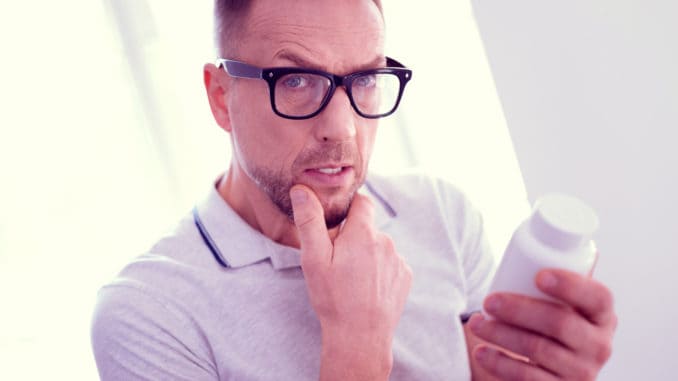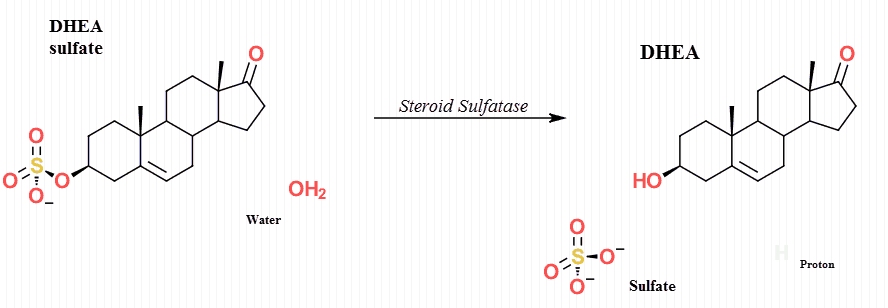
This is everything Big Pharma doesn’t want you to know… because then who would buy their treatments?
—-Important Message From Our Sponsor—-
THIS skyrocketed my testosterone levels by 162% – in just 20 nights
In just 20 short days… THIS male vitality breakthrough unleashed a flood of male sex hormones throughout my body…
And my blood levels of testosterone jumped from 276 ng/dl to 706 ng/dl…
A 162% increase…
And right away, I start experiencing a “revved up” metabolism… turbocharged energy levels… even more stamina in bed…
———-
How DHEA can save you from impotence and even cancer
The most consistent finding concerning aging and hormones is the substantial decrease of DHEA and DHEA sulfate, amounting to approximately 3% per year.
This is the most salient change, far in excess of the yearly decrease in free or bound testosterone.
Yet, since DHEA is widely considered inactive this isn’t considered a problem… But it is!
It’s been shown that DHEA is a precursor to testosterone synthesis in male organs…
And, since this occurs within target cells, it’s not reflected in serum levels.
That is to say, the importance of DHEA has long been unrealized because the androgens it produces cannot be discerned with blood tests.
This contribution from DHEA is substantial…
It has been shown that patients who have been castrated – as a “treatment” for cancer – still have 40% of the prostate testosterone levels as control subjects.
This means that, even without testicles, the adrenals can release enough DHEA to supply male organs with nearly half of their normal androgen requirement!
This secondary adrenal pathway to testosterone is likely why castration doesn’t always lead to complete impotence.
This finding, along with the small DHT deficits seen with aging, has led to the prevailing idea that androgens aren’t responsible for all cases of “rockiness” problems.
Yet this is an erroneous view…
It has been shown that the antiandrogen flutamide, when given to castrated animals, reliably causes full and complete impotence in all cases.
So there’s reason to suppose that androgens are actually responsible in nearly all cases, or those not caused by cardiovascular disease…
“This paper is the first demonstration that penile erection in the rat is almost entirely dependent on androgens – not just partially dependent, as has been suggested by previous studies conducted in castrated rats.”
In accordance with this view, oral DHEA supplementation has been shown to improve “rockiness” in a randomized clinical trial (see below).
So it would seem that the declining DHEA levels is the cause of the age‑dependent decrease in penile function in many men.

Yet you won’t hear this from the mainstream media – because “rockiness” treatments are a multibillion dollar industry.
Any affordable, unregulated, and effective “rockiness” supplement constitutes a threat to sales of Viagra etc. – and the advertising revenue they bring to publishers.
For the foreseeable future, the ability of DHEA to prevent “rockiness” problems will likely remain a secret among scientists, researchers, medical doctors…and readers of this newsletter.

The idea that “rockiness” problems are entirely preventable may sound too good to be true, so below is some evidence for the claim:
This study was inspired by findings from the Massachusetts Male Aging Study (MMAS).
In that study (MMAS), out of 17 hormones tested, they showed DHEA sulfate alone to be strongly correlated with impotence.
Out of 1,290 participants, neither serum cortisol, testosterone, nor DHT bore any consistent relationship with impotence.
“In MMAS, of 17 hormones measured, only dehydroepiandrosterone (DHEA) sulfate was strongly associated with impotence.”
So, for this study, they recruited 40 impotent men with normal serum testosterone and low DHEA sulfate (under 1.5 µg/dL), all of them free of cardiovascular disease.
They divided the subjects into two groups:
One group got a placebo and the other got 50 mg of DHEA per day – a dose previously shown to restore normal levels within two weeks.
This was a double‑blind study, so neither the doctors nor the patients knew who was getting what.
They measured five parameters:
- Penile function
- Intercourse satisfaction
- Overall satisfaction
- Sexual desire
- Orgasmic function
And all of these improved exclusively in the DHEA group…

…with no untoward side effects reported.
They even measured prostate volume by ultrasound.
And that decreased in the DHEA group, which is surprising considering androgens would generally be anticipated to have the opposite effect.
“The mean values for prostate volume decreased slightly in the DHEA group and increased slightly in the placebo group.”
This trend in improved penile function showed no sign of decreasing either, suggesting that results could keep accumulating even after 24 weeks…
But this study was received for publication the same year that Viagra hit the market and printed a year later…
So these findings were largely overlooked in the pharmaceutical gold rush that followed.
Yet DHEA can do many things Viagra and its cousins cannot…
And one of those is to cause a lasting response.
Although Viagra is effective when taken on demand, requiring a pill is often inconvenient and humiliating besides.
Moreover, DHEA is a natural metabolite that just decreases with age anyway.
Many tissues have been demonstrated to convert DHEA into testosterone directly…
And the enzymes required for this process have been found in many more.

Steroid sulfatase constitutes the first step towards testosterone synthesis, converting DHEA sulfate into DHEA:
A few other steroids are also sulfated, which is simply a means to enhance their plasma solubility and distribution.
Steroid sulfatase is ubiquitously expressed and can be detected in the prostate, testicles, and penis among other places.
The next step is 3β‑hydroxysteroid dehydrogenase/Δ5‑Δ4‑isomerase (3β-HSD).
This enzyme converts DHEA into androstenedione (A4), a hormone the body uses to produce testosterone.
It does this using NAD+/NADH (two forms of nicotinamide adenine dinucleotide) as cofactors.

NAD+/NADH is widely expressed in neural tissues, and nerves are what control the erectile response.
It has been shown that stimulation of the cavernous nerve invariably leads to erections in rats.
The last step is accomplished by 17β‑hydroxysteroid dehydrogenase (17β-HSD), another NAD+/NADH enzyme.
This catalyzes the transition of androstenedione into testosterone:

17β-HSD is also widely expressed, being found in the penis and testes.
So it would seem as though most tissues have the enzymes to convert DHEA sulfate into testosterone – but of course only androgen‑responsive tissues would benefit.
For this to happen, it would also require 5α‑reductase (an enzyme involved in steroid metabolism) to convert testosterone into DHT, the most potent androgen.
And it also requires the androgen receptor (AR) to induce transcription.
This is where sex differences really come into play…
Even though both males and females convert DHEA into testosterone, only male sex organs express 5α‑reductase type 2.
Females of course have none of this, instead converting testosterone into estradiol via aromatase.
It’s common knowledge that androgens are important for sexual development in males…
But it is less well known that men need androgens to maintain function throughout life.
Studies show that rats castrated after puberty have only about 60% of the noradrenergic pelvic nerve size as controls after four weeks.
Besides being necessary for neuron size, androgens are also responsible for transcribing for nitric oxide (NO) synthase and tyrosine hydroxylase.
These two enzymes are the mechanism by which androgens enhance the erectile response.
So this is important…

After discovering that nitric oxide synthase (NOS) was present in the male sex organs of rats, these researchers set out to determine if it would be modulated by androgens.
To accomplish this they used three groups of rats:
- A control group
- A castrated group
- And a castrated group given testosterone
After only seven days, the researchers analyzed the rats’ tissues for NOS activity and enzyme content.
They found that, of all tissues analyzed, the penis had the most NOS activity.
“In unoperated control rats, the penis contained a substantial amount of nitric oxide synthase activity and had the highest concentration of nitric oxide synthase in the reproductive tract when expressed as activity per milligram protein.”
This is intuitive, and also readily believable – considering the known effects of NO on erections.
They also found that castration would affect NOS activity – as determined by 3H- citrulline formed from 3H-arginine – with the greatest reductions seen in the penis.

Castration reduced penile NOS activity by 45%.
Yet, predictably, testosterone supplementation completely prevented this decrease from occurring.
They also did a Western blot using antibodies towards neuronal nitric oxide synthase (nNOS)…
And this proved that this had occurred – at least in part – by downregulation of this particular enzyme type:

And these findings were quickly replicated…
Researchers from California reported similar findings one year later (Penson, 1996), and another group from Georgia did so a year after that (Reilly, 1997).
They showed, using NOS inhibitors and NO‑releasing agents, that erections are completely dependent on NO.
Also, castration reduced the mRNA-encoding nNOS by approximately 50%.
This finding is in accordance with the 45% reduction in NOS activity reported by Chamness (above).
A decade earlier, other researchers reported similar findings with androgens and tyrosine hydroxylase.
And that provided some of the earliest evidence that dopamine and norepinephrine are involved in the penile response.
Although we need to have nNOS on standby for activity, there has to be some neurotransmitter available to activate it as needed.
This is where catecholamines come in…
There is now enough evidence to confidently state that “rockiness” is inhibited by norepinephrine via the hypogastric nerve…
And also that they are stimulated by dopamine through the cavernous nerve.
“The flaccid penis is in a moderate state of contraction, as evidenced by further shrinkage in cold weather and after phenylephrine injection.”
So androgens are ultimately NO‑producing hormones… But they do this by upregulating nNOS – and then only in certain target organs.
This fact makes androgens much safer than NO‑donors (e.g. nitrates and sodium nitroprusside), which release NO wholesale into the circulation system.
The amount of nitric oxide released by the penis would contribute a negligible amount to the general circulation…
Even in porn stars.
Dehydroepiandrosterone (DHEA) is even safer because its conversion is regulated…
And that means it would be unlikely to increase testosterone much beyond what you’d find in young adults.
Topical DHEA would be even safer yet, and theoretically effective for preventing “rockiness” problems.
“In all cases, in animals with less circulating androgens (either because of castration or aging), [boners] are more difficult to elicit, are maintained for shorter times, and achieve lower pressures than those in intact animals.” (Keast, 1999)
Well, you don’t want to be that animal. So you might want to give DHEA a try, along with all of our other advice.
—-Important Message—-
7 minute method “brings back boners” — try it now

Want to impress her the next time you two are in bed together?
Make her eyes widen as she sees a bigger, more engorged “you” standing at attention?
Truthfully, the secret to getting a bit bigger and fatter “down there” is really all about oxygen.
Oxygen makes a boner fuller and taller, and it helps a man last longer too.
Oxygen is the key to bringing back powerful, long-lasting erections again.
And my protocol for getting more oxygen to your member works in just 7 minutes.
So you can do it right now as a test-drive, and then again when you’re with a lucky girl…
Here’s the oxygenate-your-member protocol for men (free to you today).
———-
